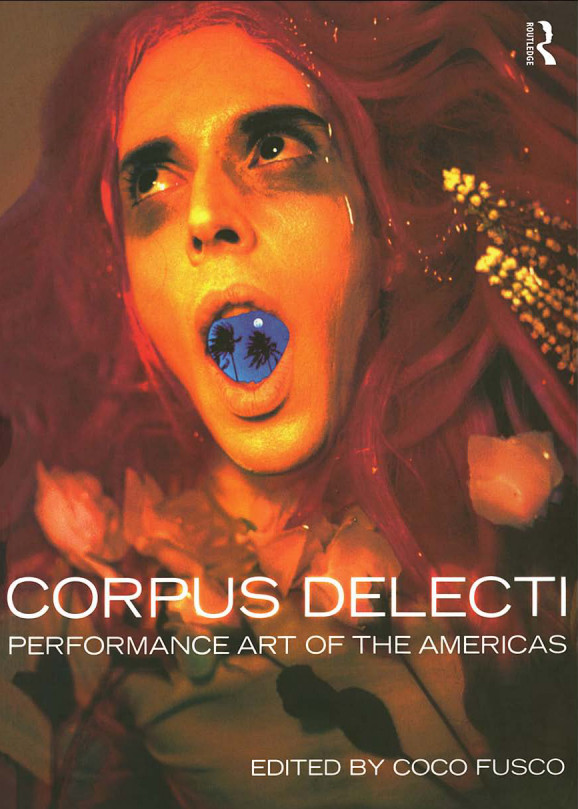Coco Fusco (ed.): Corpus Delecti: Performance Art of the Americas (2000)
Filed under book | Tags: · art history, body, latin america, performance, performance art, theatre

“Corpus Delecti is a unique collection of historical and critical studies of contemporary Latin performance. Drawing on live art from the 1960s to the present day, these fascinating essays explore the impact of Latin American politics, popular culture and syncretic religions on Latin performance.
Including contributions by artists as well as scholars, Fusco’s collection bridges the theory/practice divide and discusses a wide variety of genres. Among them are body art, carpa, vaudeville, staged political protest, tropicalist musical comedies, contemporary Venezuelan performance art, the Chicano Art movement, and queer Latino performance.
The essays demonstrate how specific social and historical contexts have shaped Latin American performance. They also show how those factors have affected the choices artists make, and how their work draw upon and respond to their environment.”
Publisher Routledge, 2000
ISBN 0415194547, 9780415194549
307 pages
Reviews: Lisa Wolford (Modern Drama, 2000), Ramon H. Rivera-Servera (Theatre J, 2001).
PDF (updated on 2013-1-29)
Comment (0)Laikwan Pang: The Distorting Mirror: Visual Modernity in China (2007)
Filed under book | Tags: · advertising, china, cinema, film, modernity, photography, theatre, visual culture

“The Distorting Mirror analyzes the multiple and complex ways in which urban Chinese subjects saw themselves interacting with the new visual culture that emerged during the turbulent period between the 1880s and the 1930s. The media and visual forms examined include lithography, photography, advertising, film, and theatrical performances. Urbanites actively engaged with and enjoyed this visual culture, which was largely driven by the subjective desire for the empty promises of modernity—promises comprised of such abstract and fleeting concepts as new, exciting, and fashionable.
Detailing and analyzing the trajectories of development of various visual representations, Laikwan Pang emphasizes their interactions. In doing so, she demonstrates that visual modernity was not only a combination of independent cultural phenomena, but also a partially coherent sociocultural discourse whose influences were seen in different and collective parts of the culture. The work begins with an overall historical account and theorization of a new lithographic pictorial culture developing at the end of the nineteenth century and an examination of modernity’s obsession with the investigation of the real. Subsequent chapters treat the fascination with the image of the female body in the new visual culture; entertainment venues in which this culture unfolded and was performed; how urbanites came to terms with and interacted with the new reality; and the production and reception of images, the dynamics between these two being a theme explored throughout the book.
Modernity, as the author shows, can be seen as spectacle. At the same time, she demonstrates that, although the excessiveness of this spectacle captivated the modern subject, it did not completely overwhelm or immobilize those who engaged with it. After all, she argues, they participated in and performed with this ephemeral visual culture in an attempt to come to terms with their own new, modern self.”
Publisher University of Hawaii Press, 2007
ISBN 0824830938, 9780824830939
280 pages
PDF (updated on 2013-8-26)
Comments (2)Richard Abel, Rick Altman (eds.): The Sounds of Early Cinema (2001)
Filed under book | Tags: · cinema, film, film history, music, silent cinema, sound recording, theatre

The first book to examine the variety of sounds that accompanied so-called silent cinema.
The Sounds of Early Cinema is devoted exclusively to a little-known, yet absolutely crucial phenomenon: the ubiquitous presence of sound in early cinema. “Silent cinema” may rarely have been silent, but the sheer diversity of sound(s) and sound/image relations characterizing the first 20 years of moving picture exhibition can still astonish us. Whether instrumental, vocal, or mechanical, sound ranged from the improvised to the pre-arranged (as in scripts, scores, and cue sheets). The practice of mixing sounds with images differed widely, depending on the venue (the nickelodeon in Chicago versus the summer Chautauqua in rural Iowa, the music hall in London or Paris versus the newest palace cinema in New York City) as well as on the historical moment (a single venue might change radically, and many times, from 1906 to 1910).
Contributors include Richard Abel, Rick Altman, Edouard Arnoldy, Mats Björkin, Stephen Bottomore, Marta Braun, Jean Châteauvert, Ian Christie, Richard Crangle, Helen Day-Mayer, John Fullerton, Jane Gaines, André Gaudreault, Tom Gunning, François Jost, Charlie Keil, Jeff Klenotic, Germain Lacasse, Neil Lerner, Patrick Loughney, David Mayer, Domi-nique Nasta, Bernard Perron, Jacques Polet, Lauren Rabinovitz, Isabelle Raynauld, Herbert Reynolds, Gregory A. Waller, and Rashit M. Yangirov.
Richard Abel is Ellis and Nell Levitt Professor of English at Drake University, where he teaches cinema/media/cultural studies. His most recent book is The Red Rooster Scare: Making Cinema American, 1900-1910 (California, 1999), which was a finalist for the Kraszna-Krausz Moving Image Book Award. Currently he is editing the Routledge Encyclopedia of Early Cinema.
Rick Altman is Professor of Cinema and Comparative Literature at the University of Iowa. After publishing Film/Genre (British Film Institute, 1999), which won the SCS Katherine Singer Kovacs award, he edited a special issue of IRIS 27 (Spring 1999) on the “State of Sound Studies.” His current projects include a book on the silent cinema soundscape, a DVD devoted to illustrated song slides, and performances by his troupe, The Living Nickelodeon.
Publisher Indiana University Press, 2001
ISBN 0253214793, 9780253214799
327 pages
More info (publisher)
More info (google books)
PDF (updated on 2012-7-14)
Comment (0)
